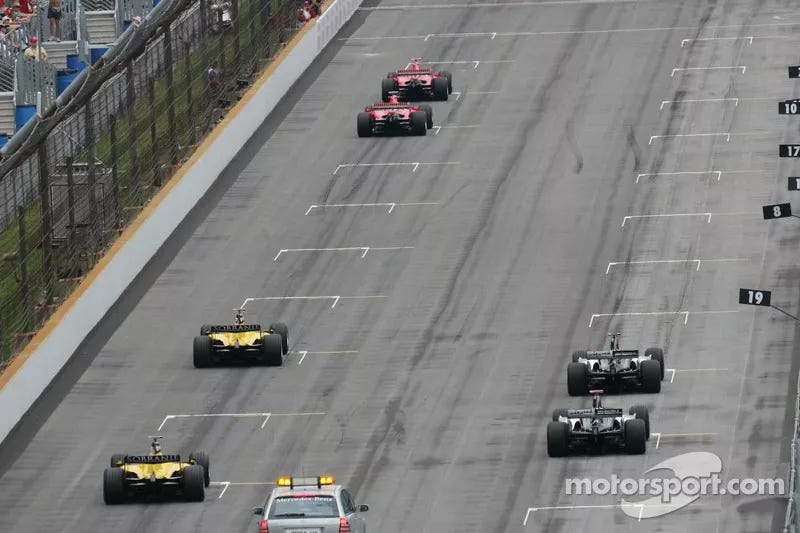Anyone who has watched a baseball game on TV can relate to that sensation of lethargy creeping in when, during the uneventful middle innings, the announcers decide to dissect pitching minutiae. Announcers, even those who aren't retired Major League pitchers, can't resist filling the airtime with discussions of pitching.
Formula 1 has its own equivalent: tire talk. While the topic of tires is highly relevant to the race, it can be just as tedious. However, as an F1 fan, understanding tires is essential.
With hundreds of millions of dollars and countless hours invested in designing and building a modern Formula 1 car, the only part that actually contacts the road is a set of Pirelli tires.
As a new fan, here's a quick primer on F1 tires:
Basic principle: Softer tires are faster but wear out more quickly. This forms the foundation of race strategy and on-track drama.
Tire eras: Change is constant in F1, and the rules and regs around tires and even tire suppliers have changed over the years. When I began watching F1, it was Bridgestone. Then, F1 thought a tire war might be cool (it wasn’t), and Michelin joined the grid. Now we are in the Pirelli era; they became the sole supplier in 2011.

Rule changes: The 2022 regulations also affected tires, introducing larger 18-inch rims. These larger tires and the new design of the cars, which features a weird little eyebrow going over the front tires, have further obscured driver visibility. However, it seems that the best drivers in the world have surmounted this issue.
Tire compounds: Pirelli manufactures six tire compounds (C0, C1, C2, C3, C4, and C5), from very soft to very hard. There are also intermediate wet and full wet tires.
Tire selection: Pirelli chooses three compounds for each Grand Prix, which are referred to as soft, medium, and hard. Soft tires will always have a red stripe on the sidewall, yellow for mediums, and white for hards.
Operating temperature: Pirelli tires are incredible when they are warmed up to the correct operating temperature…which nobody seems to know! This is one of the dark arts of Formula 1. The drivers’ feel for and ability to bring those tires up to the ideal working temperature before doing a qualifying lap or starting a race can have a massive effect on performance. Despite all the money in the world, all the research, and the grids’ current personal experience with Pirelli tires, getting these tires into their operating window continues to be a massive challenge.
The trick is that if you put on a new set and then race out of the pits, weave your car all over the track, and drive really fast, doing this will heat up the surface of the tire faster than the inside or the carcass. In an ideal world, drivers would like to slowly and steadily drive around, warming up the surface and slowly bringing the carcass up to temperature. What gets in the way of that is everybody else trying to do the same thing. In F1, more so than in any other sport, there is just never enough time. Sessions run about an hour, and with the traffic created by everyone else trying to cure their tires the same way, chaos, swearing, and close calls ensue.
One example of this tire drama is Kevin Magnussen’s breathtaking Pole Position lap in Brazil last year. K-Mag (that’s what we all call him) went out on the right tire at the right time and had them up to the right temperature, and his lowly Haas, which normally runs in P15 or lower, was transformed into an elegant race car and secured a completely unexpected first Pole Position for both the Dane and his team. The excitement was breathtaking. One of F1’s greatest moments in recent years. Getting these tire temperatures right is a big deal and can go a long way to overcome some of the underlying performance differences between the cars. Perfectly warm tires on a slower car can overcome the gap in performance to faster cars. This is why so much attention and lip service is paid to tire strategy.

One last bit for 2023 - Revised Qualifying Event (RQF): In 2023, two events will feature RQF, with mandated tire compounds for each of the three qualifying sessions.
F1 occasionally experiments with new formats to enhance the spectacle, and the RQF in 2023 is one such attempt. While it may not sound exciting, these experiments have produced successful innovations in the past.
Should you want to dig into this a bit more, here is a link to F1’s primer on tires.
From this point on, any further discussion of tires on The Installation Lap will be limited to instances where it's crucial to understanding F1. Otherwise, we'll spare you the tire talk.






